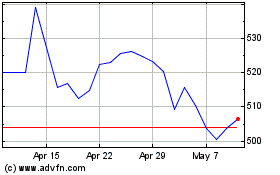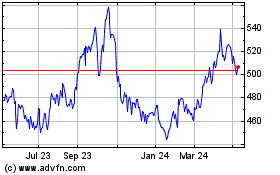BP Reports Steep Fourth-Quarter Loss -- 3rd Update
February 02 2016 - 9:32AM
Dow Jones News
By Sarah Kent
LONDON--BP PLC's earnings collapsed in 2015, the company said
Tuesday, amounting to a full-year loss of $5.2 billion that
illustrates the toll a 20-month slide in oil prices is taking on
the world's energy industry.
The U.K. oil titan said it would have to cut another 3,000 jobs
by the end of 2017 in another move to slash costs to respond to oil
prices that averaged just $44 a barrel in the last three months of
2015. For the fourth quarter alone, BP said it posted a
replacement-cost loss--a number analogous to the net income that
U.S. oil companies report--of $2.2 billion.
BP's results come after Chevron Corp. said last week it would
slash its spending by $9 billion and lay off 4,000 workers in 2016
after reporting a surprise fourth-quarter loss of more than half a
billion dollars. Exxon Mobil Corp. said Tuesday that its earnings
tumbled 58% in the fourth quarter to their lowest level since 2002.
Royal Dutch Shell PLC is also expected to report sharply lower
profits this week, after indicating last month that its adjusted
earnings fell 50% in 2015.
The pressure remains on the oil sector as the glut in supply
that has caused the downturn in oil prices shows no sign of letting
up. Prices have continued to tumble in the first two months of
2016, falling to $27 a barrel in January and trading around $33 a
barrel on Tuesday. That is down from their peak of $114 a barrel in
June 2014.
Analysts and banks lowered their price outlooks for 2016 to $50
a barrel, down from $57 a barrel, and ratings firms say their
outlook for the sector is negative. Standard & Poor's
downgraded Shell on Monday and said it would review its status
again once its roughly $50 billion acquisition of smaller rival BG
Group PLC completes. The ratings agency also placed BP and a number
of its peers on credit watch, suggesting a downgrade could follow
soon.
Despite the current market turmoil, BP's management struck an
optimistic note Tuesday, with CEO Bob Dudley replacing his mantra
of 2015--that oil prices would be "lower for longer"--with the view
that prices won't "be lower forever."
That didn't soften the blow to the company in the fourth
quarter, which suffered a significant loss at its exploration and
production unit, and impairment and restructuring charges amounting
to $2.6 billion. Its full-year loss of $5.2 billion is comparable
to the mammoth hit BP took in 2010 following its blowout in the
Gulf of Mexico.
BP's performance was much worse than analysts' already dismal
expectations. A poll of six analysts by Dow Jones Newswires
suggested the company would report a 60% slide in underlying profit
in the fourth quarter. It tanked more than 90%, prompting a 9%
selloff in BP's shares.
Mr. Dudley said he was "surprised by the reaction" to BP's
results, which he said were largely down to exploration write-offs.
"We're moving quite fast down the path to reset the company," Mr.
Dudley said at a news conference. Still, he added, "2016 is going
to be tough."
In January, BP announced plans to cut its
exploration-and-production staff by 4,000 this year. It added to
this number on Tuesday, highlighting its intention to reduce the
head count in its refining and marketing arm by 3,000 by the end of
2017. The company has outlined plans to manage spending so that it
can cover exploration-and-production costs and shareholder payouts
with cash by 2017 with oil at $60 a barrel, though that is still
nearly double the current price.
BP's downstream division remained profitable in the fourth
quarter, but its performance was significantly weaker than earlier
in the year, hurt by the performance in its trading business. For
the year, the company reported a record result in its downstream
division as profits before interest and tax nearly doubled to $7.1
billion.
Chief Financial Officer Brian Gilvary said the company's
strategy for this year was based on an oil price below $50 a
barrel, but supply and demand is expected to begin to rebalance in
the second half of the year.
BP already brought down costs by $3.4 billion in 2015 and
expects them to be $7 billion lower by 2017. Capital spending over
the next two years is expected to stay between $17 billion and $19
billion and it plans to sell off $3 billion to $5 billion worth of
assets this year.
The company's dividend, though, remains untouched at 10 cents a
share, reflecting big oil companies' continued commitment to
shareholder payouts--a measure they regard as practically
sacrosanct--despite the difficult environment.
"Provided we remain confident we can get everything back in
balance, i.e. the cash we generate will cover capital expenditure
and dividends by 2017, then the dividend remains sustainable," Mr.
Gilvary said, though he acknowledged that calculation could come
under pressure if the company's view of the market changes.
BP also took a charge of $443 million in the fourth quarter
relating to its 2010 blowout in the Gulf of Mexico. Though the
company's move to finalize the terms of a $20.8 billion settlement
with the U.S. government last year has given it some certainty over
the size of its liabilities, it will likely be decades before it
has fully shaken the incident. So far, the company has paid out
$55.5 billion before taxes in relation to the spill.
Write to Sarah Kent at sarah.kent@wsj.com
(END) Dow Jones Newswires
February 02, 2016 10:17 ET (15:17 GMT)
Copyright (c) 2016 Dow Jones & Company, Inc.
Bp (LSE:BP.)
Historical Stock Chart
From Jan 2025 to Feb 2025

Bp (LSE:BP.)
Historical Stock Chart
From Feb 2024 to Feb 2025
